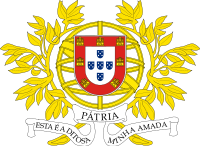- Coat of arms of Portugal
-
Coat of arms of Portugal 
Versions 
Lesser arms, used on the national flag, and governmental flags of the Republic
Military coat of arms of PortugalDetails Adopted 30 June 1911 The coat of arms of Portugal was officially adopted on 30 June 1911, along with the republican flag of Portugal. It is based on the coat of arms used by the Portuguese Kingdom since the Middle Ages.
Contents
History and meaning
The Portuguese coat of arms is the result of almost a millennium of modifications and alterations. Starting with Henry of Burgundy blue on a silver cross, successive elements were added or taken, culminating with the complex heraldic design that was officially adopted in 1911 (after the Republican Revolution of 1910). The two stripes bear the colours of the Portuguese flag: red and green.
Escutcheons and bezants
After the official recognition of the Kingdom of Portugal as an independent country in 1143 (it had been declared in 1139), silver bezants were added to the Burgundian flag, symbolising coins and the right the monarch had to issue currency, as leader of a sovereign state. Eventually, and given the enormous dynamism of medieval heraldry, it is believed that the shield degraded and lost some elements in battle, eventually losing the cross format. This is how King Sancho I inherited the shield from his father, Afonso Henriques, with no cross and five escutcheons (known in Portuguese as quinas), which stood where the silver bezants had been placed.
Later, the number of silver bezants in each escutcheon would be reduced from eleven to five by King Sebastian I, and modern explanations interpret them as the five wounds of Jesus Christ, although this is highly improbable.
Castles
It was during the reign of Afonso III that the red border with golden castles (not towers, as some sources state) was added. Although the number of castles could vary between eight to twelve, Afonso IV would define them as twelve and Sebastian I would finally fix them as seven. They supposedly represent the Moorish castles conquered by the Kingdom of Portugal during the Reconquista. Their origin is probably Castilian, but unlike Spanish castles, which usually have their gates coloured blue (hence opened), Portuguese castles were always depicted with gold gates (hence closed). As a matter of fact, Afonso III was the second son of King Afonso II of Portugal and thus was not expected to inherit the throne, which was destined to go to his elder brother King Sancho II of Portugal. As a second son, the coat of arms of Afonso III included both the arms of his father and the arms of his mother Urraca of Castile, thus the castillan red border with golden castillan castles, around the portuguese shield inherited from his father.
Armillary sphere
An important element of Portuguese heraldry since the 15th century, the armillary sphere was many times used in Portuguese colonial flags, mainly in Brazil. It was a navigation instrument used to calculate distances and represents the importance of Portugal during the Age of Discovery, as well as the vastness of its colonial empire when the First Republic was implemented.
Although it is commonly used as a "republican" element, as opposed to the monarchist crown in the blue/white flag (see Flag of Portugal), some monarchist flags, such as the flag of the United Kingdom of Portugal, Brazil and the Algarves, already depicted armillary spheres. The incorporation of the armillary sphere into the 1816 flag of the United Kingdom of Portugal is related to the adoption of the first flag of the Kingdom of Brazil, an armillary sphere on a blue background.
Crowns
The coat of arms sported different crowns during imperial rule of Portguese and foreign crowns.
- pre mid-1500s the coat of arms had a open imperial crown
- Crown of the House of Habsburg
- Crown of House of Braganza-Saxe-Coburg and Gotha with influence from the Germanic House of Saxe-Coburg and Gotha
Evolution of the Portuguese shield
Royal Coats of Arms of Portugal
See also
Coats of arms of Europe Sovereign
states- Albania
- Andorra
- Armenia
- Austria
- Azerbaijan
- Belarus
- Belgium
- Bosnia and Herzegovina
- Bulgaria
- Croatia
- Cyprus
- Czech Republic
- Denmark
- Estonia
- Finland
- France
- Georgia
- Germany
- Greece
- Hungary
- Iceland
- Ireland
- Italy
- Kazakhstan
- Latvia
- Liechtenstein
- Lithuania
- Luxembourg
- Macedonia
- Malta
- Moldova
- Monaco
- Montenegro
- Netherlands
- Norway
- Poland
- Portugal
- Romania
- Russia
- San Marino
- Serbia
- Slovakia
- Slovenia
- Spain
- Sweden
- Switzerland
- Turkey
- Ukraine
- United Kingdom
- (England
- Northern Ireland
- Scotland
- Wales)
- Vatican City
States with limited
recognition- Abkhazia
- Kosovo
- Nagorno-Karabakh
- Northern Cyprus
- South Ossetia
- Transnistria
Dependencies
and other territories- Åland
- Faroe Islands
- Gibraltar
- Guernsey
- Jan Mayen
- Jersey
- Isle of Man
- Svalbard
Other entities Categories:- National coats of arms
- Portuguese coats of arms
- National symbols of Portugal
Wikimedia Foundation. 2010.








